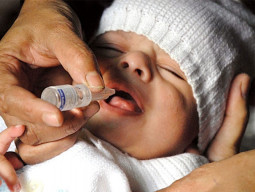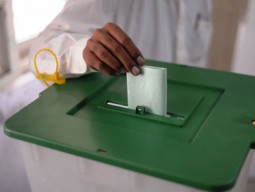
PESHAWAR: Health experts involved with polio eradication say parents are unaware the virus does not just lead to paralysis but can also cause death, however, in rare cases. According to the World Health Organization media centre, “among those paralysed, 5% to 10% die when their breathing muscles become immobilised”.
Even though the government said it would deal with the virus on a “war footing” and initiated the National Emergency Action Plan for Polio Eradication four years ago, around 691 cases have been confirmed since October 2, 2011. However, the death toll is yet to be validated.
Virus in the water
Things have seemingly improved dramatically over the past few months; officials maintain the number of cases has dropped by 70%. Yet the country is far from being considered “polio free,” with at least 36 cases in 2015.
Sewage samples from Larama tested positive for the virus. On Monday officials privy to the development said samples from the city tested positive for wild poliovirus after a gap of five months. This development comes in the wake of two confirmed cases in the city which took the provincial toll to 15. The most recent one was confirmed on October 2 from Sheikhan.

Keeping in mind that many children are still not vaccinated, health professionals remind parents that albeit rare, polio can still kill.
Dr Imtiaz Ali Shah is the focal person at the CM Polio Cell. Talking to The Express Tribune, he said, “It occurs with one in a million cases but polio can cause death too.” He said in the past there were virus carriers who died but since an autopsy was not carried out, the cause of death was never confirmed. “We [as experts] say the virus could have caused the deaths but in the absence of autopsy reports, there is no confirmation.”
Shah said polio normally affects the nervous system but when it reaches the chest muscles, it can paralyse the respiratory system causing death. Shah said, “Both arms and legs are affected in only 0.1% cases. Out of 100 infected children, 72 don’t have visible symptoms.” He added one out of four might display flu-like symptoms.
Since the ban
The focal person said health departments tackling the virus in both the province and tribal areas have done well to restrict polio. “Progress was tough since the first polio worker was targeted in December 2012 and bans on drives were imposed in North and South Waziristan agencies and FR Bannu.” He said the law and order situation and 2013 general elections diverted the government’s attention.
Tackling missed children
“Polio teams find Repeated Short Interval Additional Dosage campaigns difficult,” said Shah. He suggested attention should be diverted towards children who have continually missed during vaccination drives and that integrated planning should be carried out at the union council level. “High-risk and underdeveloped areas should be targeted using locally-tailored methods,” he added.
When contacted, WHO official in Islamabad, Dr Zubair Wadood, said polio causes death but the rate stands at 0.5%. “The virus does not affect 95% of the children. Only 3 to 4% complain of flu and fever while only 1% of them are paralysed,” he told The Express Tribune. He approximated seven children, out of 306 cases reported in 2014, lost their lives.
Around 5.3 million children were inoculated in a three-day drive earlier this month across the province. The drive could not be conducted in Chitral due to devastation caused by floods and in Upper and Lower Dir due to by-polls. In addition to those from K-P, at least 11 cases have been reported from the Federally Administered Tribal Areas, six from Balochistan and four from Sindh.
Published in The Express Tribune, October 6th, 2015.




























































COMMENTS
Comments are moderated and generally will be posted if they are on-topic and not abusive.
For more information, please see our Comments FAQ